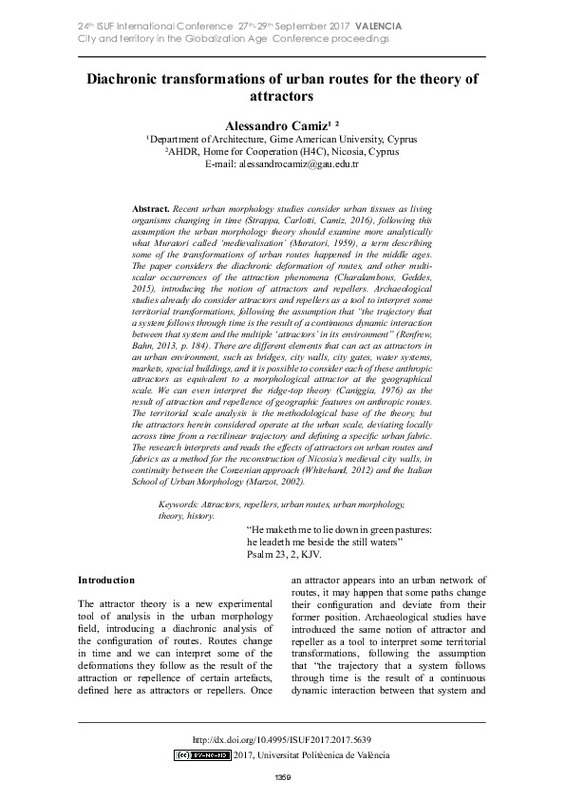JavaScript is disabled for your browser. Some features of this site may not work without it.
Buscar en RiuNet
Listar
Mi cuenta
Estadísticas
Ayuda RiuNet
Admin. UPV
Diachronic transformations of urban routes for the theory of attractors
Mostrar el registro sencillo del ítem
Ficheros en el ítem
| dc.contributor.author | Camiz, Alessandro
|
es_ES |
| dc.date.accessioned | 2018-12-17T09:22:18Z | |
| dc.date.available | 2018-12-17T09:22:18Z | |
| dc.date.issued | 2018-04-20 | |
| dc.identifier.isbn | 9788490485743 | |
| dc.identifier.uri | http://hdl.handle.net/10251/113899 | |
| dc.description.abstract | [EN] Recent urban morphology studies consider urban tissues as living organisms changing in time (Strappa, Carlotti, Camiz, 2016), following this assumption the theory should examine more analytically what Muratori called ‘medievalisation’ (Muratori, 1959), a term describing some of the transformations of urban routes happened in the middle ages. The paper considers the diachronic deformation of routes, and other multi-scalar occurrences of the attraction phenomena (Charalambous, Geddes, 2015), introducing the notion of attractors and repellers. Archaeological studies already do consider attractors and repellers as a tool to interpret some territorial transformations, following the assumption that “the trajectory that a system follows through time is the result of a continuous dynamic interaction between that system and the multiple 'attractors' in its environment” (Renfrew, Bahn, 2013, p. 184). There are different elements that can act as attractors in an urban environment, such as bridges, city walls, city gates, water systems, markets, special buildings, and it is possible to consider each of these anthropic attractors as equivalent to a morphological attractor at the geographical scale. We can even interpret the ridge-top theory (Caniggia, 1976) as the result of attraction and repellence of geographic features on anthropic routes. The territorial scale analysis is the methodological base of the theory, but the attractors herein considered operate at the urban scale, deviating locally across time from a rectilinear trajectory and defining a specific urban fabric. The research interprets and reads the effects of attractors on urban routes and fabrics as a method for the reconstruction of Nicosia’s medieval city walls, in continuity between the Conzenian approach (Whitehand, 2012) and the Italian School of Urban Morphology (Marzot, 2002). | es_ES |
| dc.format.extent | 11 | es_ES |
| dc.language | Inglés | es_ES |
| dc.publisher | Editorial Universitat Politècnica de València | es_ES |
| dc.relation.ispartof | 24th ISUF International Conference. Book of Papers | es_ES |
| dc.rights | Reconocimiento - No comercial - Sin obra derivada (by-nc-nd) | es_ES |
| dc.subject | Attractors | es_ES |
| dc.subject | Repellers | es_ES |
| dc.subject | Urban routes | es_ES |
| dc.subject | Urban morphology | es_ES |
| dc.subject | Theory | es_ES |
| dc.subject | History | es_ES |
| dc.title | Diachronic transformations of urban routes for the theory of attractors | es_ES |
| dc.type | Capítulo de libro | es_ES |
| dc.type | Comunicación en congreso | es_ES |
| dc.identifier.doi | 10.4995/ISUF2017.2017.5639 | |
| dc.rights.accessRights | Abierto | es_ES |
| dc.description.bibliographicCitation | Camiz, A. (2018). Diachronic transformations of urban routes for the theory of attractors. En 24th ISUF International Conference. Book of Papers. Editorial Universitat Politècnica de València. 1359-1369. https://doi.org/10.4995/ISUF2017.2017.5639 | es_ES |
| dc.description.accrualMethod | OCS | es_ES |
| dc.relation.conferencename | 24th ISUF 2017 - City and Territory in the Globalization Age | es_ES |
| dc.relation.conferencedate | Septiembre 27-29,2017 | es_ES |
| dc.relation.conferenceplace | Valencia, Spain | es_ES |
| dc.relation.publisherversion | http://ocs.editorial.upv.es/index.php/ISUF/ISUF2017/paper/view/5639 | es_ES |
| dc.description.upvformatpinicio | 1359 | es_ES |
| dc.description.upvformatpfin | 1369 | es_ES |
| dc.type.version | info:eu-repo/semantics/publishedVersion | es_ES |
| dc.relation.pasarela | OCS\5639 | es_ES |








